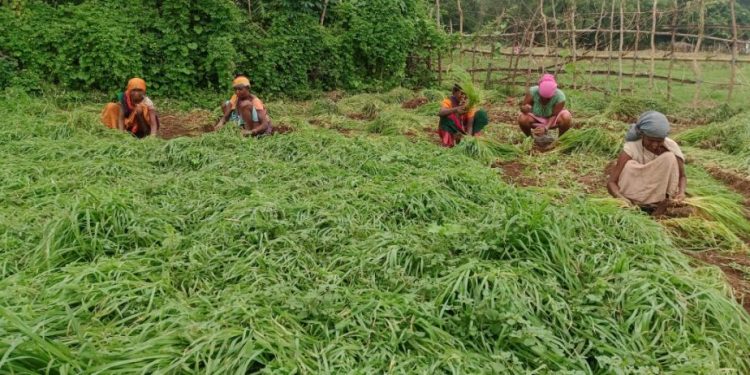Rayagada: The Government of India has been promoting millet as a safe bet to enhance farmers’ income and as a reliable grain to ensure India’s nutritional and food security. Its cultivation takes place between June to August as high-quality millet is produced during the kharif season. Seeds are sown like paddy crops and later the saplings are replanted in row cultivation methods. However, despite all the hype over millet as a superfood, Odisha lags behind in millet production in comparison to other states in the country regardless of the favourable soil and weather conditions in the state.
According to data from the Agriculture Department, out of the total millet produced in the country, Karnataka accounts for 66 per cent while Odisha’s share is only 2.16 per cent of the total production. In the state, Koraput district stands first while Rayagada comes second in millet cultivation. The state government has been providing various benefits for the welfare of millet farmers through Odisha Millet Mission. However, the farmers have failed to get the right price for their crops due to the apathetic attitude of the concerned authorities.
Middlemen and agents are calling the shots in mandis and procuring millet from the farmers at Rs 25-30 per kg instead of the government-approved price of Rs 40. The Agriculture Department claims that 11-12 quintal of millet is harvested per hectare of land, which has been rejected by Indu Chandra Majhi, a millet farmer from this district. Majhi claims that actually 8 to 10 quintal of millet is harvested per hectare of land. Farmers claimed they earn around Rs 10,000 to Rs 12,000 if the farmland is fertile but they have to spend around Rs 15,000 to Rs 18,000 if the soil is non-fertile and fertiliser is used. They do not get the right price as middlemen and agents call the shots in mandis and do the price fixation. They demanded the state government’s intervention in order to solve their problem. The bumper production of the crop helps the country to export it to foreign countries like the USA, United Arab Emirates, Nepal, and other countries.
Sources from Odisha Millet Mission said that 12,654 farmers cultivated millet last year. Reports from the Agriculture Department say that out of 11 blocks in Rayagada, millet was cultivated on a maximum 7,355 hectare of land in Kashipur block and the lowest on 230 hectares in Ramnaguda. Accordingly, millet cultivation was carried out on 1,913 ha in Bissam Cuttack, 3,546 ha in Muniguda, 1,272 ha in Chandrapur, 567 ha in Gudari, 230 ha in Ramnagauda, 1,805 in Rayagada, 1,020 ha in Kolnara, 1,550 ha in Kalyansinghpur, 837 ha in Gunupur and 250 ha in Padmapur blocks. A close analysis of the millet cultivation undertaken in the last five years reveals that the state government had targeted cultivation on 12,600 hectares of land in 2019 but it was done on 12,789 ha of land. The total production was 11,465 metric tonnes from this cultivation. Similarly, millet cultivation was planned for 11,145 ha in 2020 but it was done on 11,340 ha.
The total production was 11,465 metric tonne. In 2021, millet cultivation on 20,232 ha produced 22,599 metric tonne and in 2022, it was taken up on 20,245 ha and the production was 22,310 metric tonne. When contacted, Manoj Kumar, district project manager (DPM) of Odisha Millet Mission said that the state government is providing incentives to the registered millet farmers.
Out of the total incentive of Rs 26,500 per hectare in five years, farmers have been provided with Rs 10,000 in the first year, Rs 7,500 in the second year, Rs 5,000 in the third year and Rs 2,000 each in the fourth and fifth years, he said. This is the only incentive available to the farmers through Odisha Millet Mission. Farmers alleged that the government has also made arrangements for farm producers’ group for the preparation of various food items and snacks from millets but they are yet to get the benefits.







































